Step 1: Have faith!
On Friday 8th May 2009 my wife,
Rachel, gave birth to our second daughter and I had the amazing experience of being her
midwife and delivering the baby! Elizabeth Hannah Olivia Pattisson was born weighing 6lb 13oz (3.1kg).
Step 2: Encourage and support the mother
The “delivery of a baby” sounds like an easier thing than it really is. In contrast, a surprising number of people think of childbirth as a fairly horrific and frightening thing. Having witnessed it twice now, I know it to be an incredible feat on the part of the mother but nothing to be fearful of. The ease or difficulty of the birth depends greatly on the
mother’s attitude and peace of mind and the father’s role is simply to reassure her; after all, there’s not usually much else they can do! However this time things were a little different…
Step 3: Be prepared
This birth was always planned as a home birth. The NHS had given us a
whole bunch of medical equipment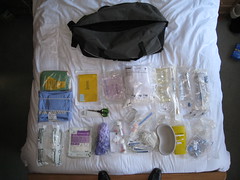
– none of which we used in the end – and we had prepared by buying a shower curtain to protect the carpet and getting old towels at the ready. It wasn’t our intention to go-it-alone although neither did we want the midwives there too early. Apart from the fact that they were going to want to “monitor” Rachel after every contraction which seemed a bit excessive, the midwives were restricted to a maximum of four hours “on site” so we didn’t want to call them prematurely. I’d taken the precaution of swatting up on what to do if I was to find myself delivering the baby on the Internet and found a whole load of
funny and
terribly acted training videos.
Step 4: Call the midwife
The series of events were as follows: Waters broke at 23:53 on Thursday. Some contractions had already been happening before this time although they were sporadic and inconsistent but it was a sharp kick during a contraction that had ruptured the amnion. We first called the Midwife at 00:31 on Friday morning to inform them that Rachel was in labour and really to ask when they should come. Their assessment was that Rachel wasn’t really in labour yet (sounded far too calm on the phone) and so we said we’d call back in a couple of hours to let them know how we were getting on. In reality Rachel was already in labour and from about 00:45 her contractions were consistently four minutes apart and nearly 60 seconds in duration. As most will know, lengthy contractions like this, at regular intervals, signal that established labour has begun. During this time Rachel was controlling her breathing by taking big intakes of breath and blowing four short puffy breaths out, while thinking to herself “I-must-not-push” along with each of the short breaths. All I could do was time the contractions and rub her lower back to try to alleviate the pressure there. In actual fact, this was a token gesture which just reassured Rachel she was not alone and did little to alter the sensations she was experiencing. She had decided not to have any pain control (anaesthetic) so it was not a problem that we were still on our own at this point. Every now and again she’d have a sip of water between contractions and that was really all she wanted. Amazingly her body gave her breaks. Occasionally she’d have a longer than usual gap between contractions, just enough to regain strength, however these were usually followed by a contraction that was stronger than the others.
Step 5: Call the midwife again
At 01:56 we called midwife again to tell them that Rachel was getting on well and asking that they should come. At that point in time we had no idea that the baby was less than an hour away from popping out but we knew that it would take the midwives an hour to get there. Their routine involved convening at the hospital, picking up yet more stuff (including weighing scales) and getting to our house. It’s always difficult to judge how far-on labour is, especially if you’re not trained in this. Every mother is different and every delivery is different from the last, although
typically quicker. By 02:20 Rachel made it clear that things weren’t going to take much longer and we were getting to the pushing stage – a mother’s instincts are usually right. We knew from the last birth that Rachel should resist the urge to push until her cervix was 10cm dilated. As a result we were waiting for the midwives to turn up, make an assessment of her degree of dilation and give her the green light for pushing to commence. However, their absence had a positive effect because it meant Rachel and I knew pushing was not an option yet. The self-control Rachel must have had is beyond me, as the urge to push is apparently incredible but I tried to support her by reminding her each contraction was taking her closer and insisting that she kept breathing if she tried to hold her breath to push. This all helped to ensure the birth was gentle on her and the baby.
Step 6: Resort to plan B – be the midwife
A short while later, by 02:37, it became obvious the baby wasn’t going to wait for the midwives and the emergence of a few drops of blood panicked me! I couldn’t recall from last time if this was normal or the sign of something going wrong. All I could do was pray! I asked God to protect the baby and thanked Him that she was perfect, in the faith that she would be. Five agonising minutes later I could see the dark hair of the baby’s head crowning. I quickly grabbed a clean towel and got ready to catch her. The most memorable tip I’d read was “Don’t drop the baby – they’re slippery!” From there it was very quick, once her head was out she just gently slipped into my hands. Elizabeth was born at 02:44. Almost immediately, our precious, tiny little girl let out a cry and that was the most wonderful sound for us to hear – what relief!
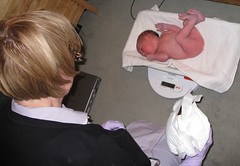
I find it truly miraculous that a newborn’s lungs are activated the instant they emerge. When the child is in the womb, a
hole in their heart allows the baby’s blood to bypass their lungs and flow directly into their circulatory system as their blood is oxygenated at the placenta instead. When they are born this hole closes to route blood to the lungs for the first time. Until that point the baby has been “breathing” the amniotic fluid into their lungs and that has had to be expelled too to make way for their first breath of air!
Step 7: Don’t cut the cord
At about 3am the midwifes arrived (15 minutes too late)! Elizabeth was still attached by the umbilical cord when as we knew there was no need for us to worry about cutting it before they got there. The most important thing was to keep her warm and get her to the breast. As soon as the mother starts to breastfeed, hormones are released which initiate the separation of the placenta and the subsequent afterbirth. Rachel even remarked that it was possible to feel this change taking place as Elizabeth began to feed.
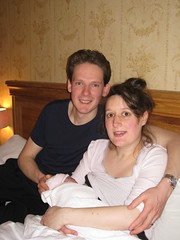
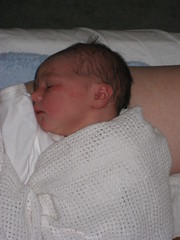
Step 8: Praise the Lord!
All in all it was very special to be able to witness and take part in the birth. It was and is every time a child is born, a little miracle - no doubt about it!
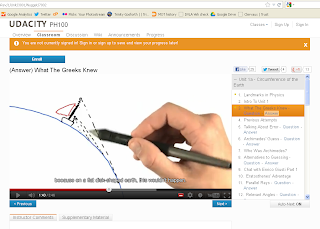

 – none of which we used in the end – and we had prepared by buying a shower curtain to protect the carpet and getting old towels at the ready. It wasn’t our intention to go-it-alone although neither did we want the midwives there too early. Apart from the fact that they were going to want to “monitor” Rachel after every contraction which seemed a bit excessive, the midwives were restricted to a maximum of four hours “on site” so we didn’t want to call them prematurely. I’d taken the precaution of swatting up on what to do if I was to find myself delivering the baby on the Internet and found a whole load of funny and terribly acted training videos.
– none of which we used in the end – and we had prepared by buying a shower curtain to protect the carpet and getting old towels at the ready. It wasn’t our intention to go-it-alone although neither did we want the midwives there too early. Apart from the fact that they were going to want to “monitor” Rachel after every contraction which seemed a bit excessive, the midwives were restricted to a maximum of four hours “on site” so we didn’t want to call them prematurely. I’d taken the precaution of swatting up on what to do if I was to find myself delivering the baby on the Internet and found a whole load of funny and terribly acted training videos.

